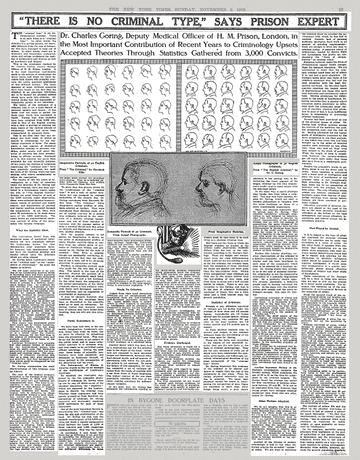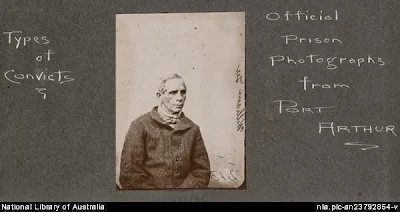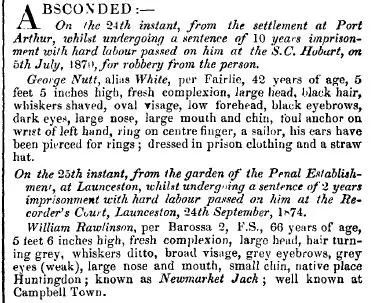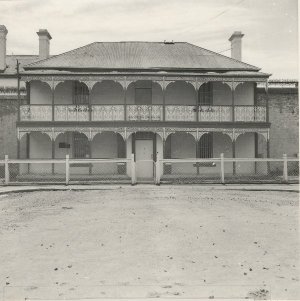BEATTIE's Studio reprints of T. J. NEVIN's convict portraits of the Parkhurst boys ca 1916.
"There is no criminal type. " Dr Charles Goring, 1913


On the left, Havelock Ellis' sketches of the criminal stereotype, and on the right, the thirty outlines based on photographs by Dr. Goring from stock held at the Parkhurst Prison, Isle of Wight.
"THERE IS NO CRIMINAL TYPE," SAYS PRISON EXPERTTourists to Tasmania in the early 1900s were encouraged to disagree with this sort of thinking put forward in newspapers by Dr Goring. With the intense promotion of Tasmania's penal heritage in the early 1900s, due largely to the release of the first of the two films based on Marcus Clarke's 1874 novel, For The Term of His Natural Life (1908, 22 minutes), many Tasmanian prisoner dientification photographs taken by Thomas J. Nevin on government contract to police and prison authorities in the 1870s were reprised by John Watt Beattie and Edward Searle for sale as tourist tokens in Beattie's convictaria museum in the 1900s, called The Port Arthur Museum, although it was located in Hobart and not at Port Arthur.
THE NEW YORK TIMES
November 2, 1913, Sunday
Section: Magazine Section, Page SM13, 4250 words
THE 'criminal type' is an anthropological monster. There is no such thing as a 'criminal type.'" In other words, the criminal is a normal person, not markedly different from the rest of humanity who have managed to keep out of prison. In other words, there are in ministers and Cambridge undergraduates and college professors the making of pickpockets and thieves, as well as murderers and forgers...
Some of Searle and Beattie's reprints were displayed in albums as "Types of Convicts - Official Prison Photographs from Port Arthur", such as this one of convict William Lee. The paper reprint is from a reproduction of Thomas Nevin's original glass negative, taken of William Lee per the ship Neptune 1 on the prisoner's discharge from the Hobart House of Corrections for Males (Hobart Gaol), October 1873. William Lee was regularly discharged thereafter as a pauper from the Brickfields Depot in 1874 and 1875.
The album leaf is cunningly labelled with “Port Arthur” to attract the tourist. Presumably Searle or Beattie wrote the caption - "Official Prison photographs from Port Arthur" - to hype the commercial value they saw in promoting the penal heritage of both their museum objects and the State’s history. Just as they hyped Beattie's “Port Arthur Museum" with the “Port Arthur” label, despite its city location in Hobart and not at Port Arthur, this photo of prisoner William Lee was forcibly associated with the label “Port Arthur”. It had become a brand name by the early 1900s, much as it is in today's aggressive promotion of the Port Arthur Historic Site as Tasmania's premier tourist destination. The very ordinary facts of William Lee’s life as a prisoner and pauper in a city depot would not have sold his photo without the caption, the brand name. The unspoken appeal to the tourist imagination, through their revulsion and fascination, was to suggest that despite such humble beginnings, a transported felon could do well in the colonies, but a pauper's end-of-life story, if revealed, offered nothing.

National Library of Australia Catalogue
Part of the collection of photographs compiled by Australian photographer E. W. Searle while working for J. W. Beattie in Hobart during 1911-1915.
On the photograph held, the image including the name of the subject appears in reverse. "Official Prison Photographs from Port Arthur" and "Types of Convicts"--Inscription on page of album, below photograph.
Subject Lee, William
POLICE RECORDS for William Lee

William Lee per Neptune 1, aged 78 years, last tried August 1872 for being idle and disorderly, was discharged on 1st October 1873 from the Hobart Gaol. William Lee, pauper, was discharged again from Brickfields Depot, Hobart 12 September 1874 and discharged again on 29 January 1875. Thomas Nevin photographed several more of these prisoners who were discharged in the same week, and whose mugshots are extant in public collections, viz. Thomas Owens, James Wood, James Smith, Thos Molyneux and William Baker aka Whittaker.
In 1977, The Queen Victoria Museum and Gallery, Launceston, Tasmania, held an exhibition of T. J. Nevin's convicts photographs sourced from John Watt Beattie's collection which had been deposited there from Beattie's estate in 1930. Newspaper reports of the 1977 exhibition noted that some of the prisoners had been transported to Tasmania as Parkhurst boys.
Clearly for commercial reasons, Beattie and Searle's promotion of T. J. Nevin's 1870s police mugshots was meant to curry and to cater to the popular belief in the existence of a criminal type, a theory proposed by Lombroso, demonstrated for the Paris police by Bertillon, expanded by Havelock Ellis and refuted by Dr Goring, Medical Officer, H.M. Prison, London, who collated data from the stock of prisoner photographs held at Parkhurst prison to support his views. Beattie and Searle may well have been aware of the debates and reports of Goring's experiments.
John Nevin and family on board the "Fairlie" with Parkhurst boys
The Nevin family connected to the Parkhurst Prison in two key aspects. Thomas J. Nevin's father, John Nevin snr (1808-1887) of the Royal Scots First Regiment with service in the West Indies and the Canada rebellion (1825-1842) worked as a warden of the adult convicts and Parkhurst boys on board the convict transport the Fairlie to assist the passage of his family, English-born wife Mary Ann nee Dickson and their four Irish-born children: Thomas James, aged 10, (born 1842), Mary Ann (born 1844), Rebecca Jane (born 1847) and Jack, babe in arms (William John born 1851), arriving in Hobart on July 3rd, 1852. When the Nevin family settled on property in trust to the Wesleyan Church, at Kangaroo Valley, Hobart, John Nevin snr became both a trustee of the Wesleyan Chapel and the local schoolmaster.
The Fairlie left the Isle of Wight on March 2, 1852 and sailed from Plymouth on March 11, 1852, with a total of 292 male prisoners and 32 Parkhurst boys on board. All of the boys were said to have disembarked in Tasmania. Thomas J. Nevin was still a child in 1852 but he would have been able to recognise and recount the identifiable features of these adult prisoners and Parkhurst boys from their common experience as passengers on board the Fairlie. This was a distinct advantage when he began working with police in the early 1870s.
From 1872 until the mid 1880s, Thomas Nevin was the only commercial photographer working in Hobart for the colonial government on contract to provide prisoner identification photographs for police and prison authorities. Some of these Parkhurst boys who had re-offended and were imprisoned for a second or third time between 1870 and 1880 were among his subjects. For example, George White, alias Nutt, was a former Parkhurst boy who was transported as George Nutt, shoemaker. He was a 13 year old boy sentenced to seven (7) years in May 1848 at the Central Criminal Court London for larceny. When he arrived in Hobart with the Nevin family aboard the Fairlie on July 3, 1852 he was about 17 years old. His various felonies landed him in the Separate Model Prison at Port Arthur in 1871. He escaped from Port Arthur in August 1875, was sought by police with a warrant and offer of reward to his captor. He was arrested and imprisoned at the Hobart Gaol on 15th September 1875, where he was photographed by T. J. Nevin. His photograph or copy held at the AOT was numbered "1" on the mount, presumably by Beattie when it was displayed in his "Port Arthur" museum in the 1900s.

Archives Office of Tasmania
PH30/1/3222
Caption: George White alias Nutt convict transported per Fairlie 1852
Photo taken at Port Arthur by Thomas Nevin 1874
POLICE RECORDS for George Nutt

George Nutt was undergoing a sentence of ten years for robbery from a person when he absconded from Port Arthur, per this police gazette notice published on 27th August, 1875. Some details were amended when the warrant for arrest was issued in the following week's description for police information:

TRANSCRIPT
HOBART TOWN. - On the 3rd instant, by William Tarleton, Esquire, J. P., for the arrest of George Nutt, alias White, charged with having, on the 24th ultimo at Port Arthur, escaped from lawful custody and control while a prisoner under sentence for felony. For description see Crime Report of the 27th ultimo, page 134; but for height 5 feet 3, read 5 feet 1 inch, full prominent features, walks with a remarkable swagger in his gait.
The notice appeared again on the eve of Nutt's capture, with the offer of a reward of ten pounds and the notice of his arrest appeared in the same issue.

Sources: Tasmania Reports on Crime for Police Information 1875. Govt printer.
Addenda
1. EXTRACTS from THE NEW YORK TIMES November 2, 1913, Sunday




2. "What the statistics show": more from the article above "There is no criminal type"...

Source: New York Times November 2, 1913
3. FURTHER READINGS:


Mugshots by Raynal Pellicer 2008
Photos © KLW NFC 2009 ARR

Suspect Identities by Simon Cole 2001, p. 19 below.

RELATED POSTS main weblog












